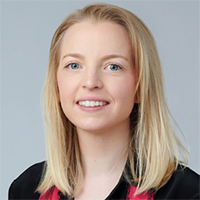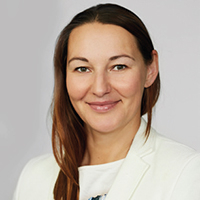
 Ogier Sustainable Investment Consulting’s Director and Head Leonie Kelly (far right) and Senior Manager Dasha Kuts set out what Channel Islands-domiciled funds should know about Sustainable Finance Disclosure Regulation
Ogier Sustainable Investment Consulting’s Director and Head Leonie Kelly (far right) and Senior Manager Dasha Kuts set out what Channel Islands-domiciled funds should know about Sustainable Finance Disclosure Regulation
All firms fundraising from the EU or planning to fundraise in the EU need to be informed about the EU’s Sustainable Finance Disclosure Regulation (SFDR) and plan to comply, as it can take time. Even funds based in Jersey and Guernsey need to plan for SFDR compliance proactively.
SFDR is one of a package of regulatory measures brought in by the EU to create a harmonised environment, social and governance framework for European financial services, and is part of the EU’s 2030 Agenda for Sustainable Development.
Since Level 1 SFDR came into effect in 2021, followed by the application of Level 2 Regulatory Technical Standards (RTS) on 1 January, the financial market has been working to understand its implications for the asset management industry, including in-scope firms in Jersey and Guernsey.
At Ogier’s Sustainable Investment Consulting, we work with asset managers and asset owners across Europe and other markets, including the Channel Islands, to understand the implications of SFDR and develop processes towards compliance.
Similar to the recommendations provided by the Task Force on Climate-Related Financial Disclosures (TCFD) framework, we encourage clients to follow the steps set out here when implementing SFDR or any other environmental, social and governance framework.
Please note that these ideas are examples only.
Navigating SFDR requirements
First, governance. It is vital to think through sustainable investment agendas systemically, to ensure business processes and action plans are developed for implementation.
This way, any risks of greenwashing or greenhushing will be minimised as responsibilities and processes will have been established, regardless of ongoing regulatory changes.
Conducting an ESG assessment or health check will help to see how the company or financial institution compares with its competition and identify areas of improvement. Asset managers normally begin this step by reviewing alignment against SFDR’s Article 6 requirements at entity and product level.
At this point, asset managers need to review and be aware of local supervisory requirements relevant to ESG as there are some differences depending on where the fund is domiciled or will be domiciled.
Starting with governance allows clients to engage relevant stakeholders, create mutual understanding and identify any gaps in their internal capacity for robust implementation and ongoing monitoring of SFDR reporting.
The road to SFDR compliance
Once responsibilities are outlined, asset managers should focus on overall strategy, which entails a review of all products marketing into the EU.
Asset managers should research best practices globally and get external advice to check compliance against Article 8 and Article 9 product-level considerations. This will help build an in-depth understanding of the market position and how you might look to achieve ESG characteristics or sustainable investment objectives.
When considering the ESG characteristic or sustainable investment goal to be delivered, managers must think holistically to set out the targets or year-on-year performance they seek to achieve against the product’s binding characteristics.
Accurate and complete data is critical to monitoring and managing your ESG characteristics – and increasing the ability of your investment teams to interpret and understand ESG data is critical.
Asset managers can bring in external advisers to support with interpreting such data and ensuring all risks and changes in ESG performance are investigated thoroughly.
The road to SFDR compliance is complex and involves many stakeholders across investment firms. To provide transparent and accurate disclosures and comply with the regulatory requirements, asset managers must overcome numerous challenges.
But for asset managers who approach the requirements proactively and seek professional guidance, being a frontrunner in ESG reporting can bring about a number of benefits and opportunities.
Sustainable Investment Consulting at Ogier has been working alongside financial market participants in Asia, US and Europe.
It has advised on SFDR alignment, conduct fund classification assessments, health checks, gap analysis on managers’ pre-contractual disclosures and website disclosures, and fundamentally developing and implementing ESG methodologies.
• This advertising feature was first published in the Funds Edition of Businesslife magazine in November 2023
About Ogier
With legal teams in Luxembourg and Ireland working with the dedicated sustainable investment consultants, Ogier is well positioned to offer:
• Holistic approach to EU SFDR requirements across EU states
• Advisory on structuring of funds, choice of domicile and ongoing requirements, including ongoing reporting as described by EU SFDR
• Gap analysis of clients’ current approach to entity and product level requirements of SFDR Level 1 and Level 2 against best practices
• Product market benchmarking
• Drafting of all necessary sustainability-related disclosures and documentations at entity and product level, including website disclosures
• Review of internal and external communications, policies and procedures to ensure that risk of inadvertent misstatements such as greenwashing are minimised
• Advisory on fiduciary duties of directors around sustainable investment objectives defined by the fund, to ensure compliance with good governance as defined in EU SFDR
• Training for boards and management, including access to ESG Align tool
• Independent verification, including checks of in-house frameworks, evaluation of compliance with stated sustainable investment or ESG policy
• Sustainable investment or ESG due diligence at a fund and portfolio company level
• Development of ESG scorecards and ratings to make sure sustainable investment policy demonstrates alignment with Article 6, 8 or 9 strategies as defined by EU SFDR
• Support with ongoing reporting, including development of periodic reports as defined by EU SFDR
• Review of investor ESG factsheet against existing policies to support successful fundraising
For further information, please visit: ogier.com/esg